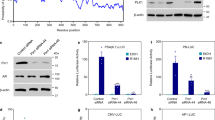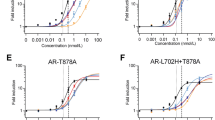Abstract
Clinical resistance to the second-generation antiandrogen enzalutamide in castration-resistant prostate cancer (CRPC), despite persistent androgen receptor (AR) activity in tumors, highlights an unmet medical need for next-generation antagonists. We have identified and characterized tetra-aryl cyclobutanes (CBs) as a new class of competitive AR antagonists that exhibit a unique mechanism of action. These CBs are structurally distinct from current antiandrogens (hydroxyflutamide, bicalutamide, and enzalutamide) and inhibit AR-mediated gene expression, cell proliferation, and tumor growth in several models of CRPC. Conformational profiling revealed that CBs stabilize an AR conformation resembling an unliganded receptor. Using a variety of techniques, it was determined that the AR–CB complex was not recruited to AR-regulated promoters and, like apo AR, remains sequestered in the cytoplasm, bound to heat shock proteins. Thus, we have identified third-generation AR antagonists whose unique mechanism of action suggests that they may have therapeutic potential in CRPC.
This is a preview of subscription content, access via your institution
Access options
Subscribe to this journal
Receive 12 print issues and online access
$259.00 per year
only $21.58 per issue
Buy this article
- Purchase on Springer Link
- Instant access to full article PDF
Prices may be subject to local taxes which are calculated during checkout





Similar content being viewed by others
References
Siegel, R., Ma, J., Zou, Z. & Jemal, A. Cancer statistics, 2014. CA Cancer J. Clin. 64, 9–29 (2014).
Rick, F.G. & Schally, A.V. Bench-to-bedside development of agonists and antagonists of luteinizing hormone-releasing hormone for treatment of advanced prostate cancer. Urol. Oncol. 33, 270–274 (2015).
Rick, F.G., Block, N.L. & Schally, A.V. An update on the use of degarelix in the treatment of advanced hormone-dependent prostate cancer. Onco Targets Ther. 6, 391–402 (2013).
Chen, Y., Sawyers, C.L. & Scher, H.I. Targeting the androgen receptor pathway in prostate cancer. Curr. Opin. Pharmacol. 8, 440–448 (2008).
Klein, K.A. et al. Progression of metastatic human prostate cancer to androgen independence in immunodeficient SCID mice. Nat. Med. 3, 402–408 (1997).
Edwards, J., Krishna, N.S., Grigor, K.M. & Bartlett, J.M. Androgen receptor gene amplification and protein expression in hormone refractory prostate cancer. Br. J. Cancer 89, 552–556 (2003).
Locke, J.A. et al. Androgen levels increase by intratumoral de novo steroidogenesis during progression of castration-resistant prostate cancer. Cancer Res. 68, 6407–6415 (2008).
Dehm, S.M. & Tindall, D.J. Alternatively spliced androgen receptor variants. Endocr. Relat. Cancer 18, R183–R196 (2011).
Li, Y. et al. AR intragenic deletions linked to androgen receptor splice variant expression and activity in models of prostate cancer progression. Oncogene 31, 4759–4767 (2012).
Nakazawa, M., Antonarakis, E.S. & Luo, J. Androgen receptor splice variants in the era of enzalutamide and abiraterone. Horm. Cancer 5, 265–273 (2014).
Chen, C.D. et al. Molecular determinants of resistance to antiandrogen therapy. Nat. Med. 10, 33–39 (2004).
Beltran, H. et al. Targeted next-generation sequencing of advanced prostate cancer identifies potential therapeutic targets and disease heterogeneity. Eur. Urol. 63, 920–926 (2013).
Hara, T. et al. Novel mutations of androgen receptor: a possible mechanism of bicalutamide withdrawal syndrome. Cancer Res. 63, 149–153 (2003).
Veldscholte, J. et al. A mutation in the ligand binding domain of the androgen receptor of human LNCaP cells affects steroid binding characteristics and response to anti-androgens. Biochem. Biophys. Res. Commun. 173, 534–540 (1990).
Clegg, N.J. et al. ARN-509: a novel antiandrogen for prostate cancer treatment. Cancer Res. 72, 1494–1503 (2012).
Tran, C. et al. Development of a second-generation antiandrogen for treatment of advanced prostate cancer. Science 324, 787–790 (2009).
Joseph, J.D. et al. A clinically relevant androgen receptor mutation confers resistance to second-generation antiandrogens enzalutamide and ARN-509. Cancer Discov. 3, 1020–1029 (2013).
Korpal, M. et al. An F876L mutation in androgen receptor confers genetic and phenotypic resistance to MDV3100 (enzalutamide). Cancer Discov. 3, 1030–1043 (2013).
Parent, A.A., Gunther, J.R. & Katzenellenbogen, J.A. Blocking estrogen signaling after the hormone: pyrimidine-core inhibitors of estrogen receptor-coactivator binding. J. Med. Chem. 51, 6512–6530 (2008).
Parent, A.A., Ess, D.H. & Katzenellenbogen, J.A. π-π interaction energies as determinants of the photodimerization of mono-, di-, and triazastilbenes. J. Org. Chem. 79, 5448–5462 (2014).
Balbas, M.D. et al. Overcoming mutation-based resistance to antiandrogens with rational drug design. eLife 2, e00499 (2013).
Norris, J.D. et al. Differential presentation of protein interaction surfaces on the androgen receptor defines the pharmacological actions of bound ligands. Chem. Biol. 16, 452–460 (2009).
Joseph, J.D. et al. Inhibition of prostate cancer cell growth by second-site androgen receptor antagonists. Proc. Natl. Acad. Sci. USA 106, 12178–12183 (2009).
Yin, D. et al. Pharmacodynamics of selective androgen receptor modulators. J. Pharmacol. Exp. Ther. 304, 1334–1340 (2003).
Gillis, J.L. et al. Constitutively-active androgen receptor variants function independently of the HSP90 chaperone but do not confer resistance to HSP90 inhibitors. Oncotarget 4, 691–704 (2013).
Ni, L. et al. FKBP51 promotes assembly of the Hsp90 chaperone complex and regulates androgen receptor signaling in prostate cancer cells. Mol. Cell. Biol. 30, 1243–1253 (2010).
Oh, S., Nam, H.J., Park, J., Beak, S.H. & Park, S.B. Development of a benzopyran-containing androgen receptor antagonist to treat antiandrogen-resistant prostate cancer. ChemMedChem 5, 529–533 (2010).
Wakabayashi, K., Imai, K., Miyachi, H., Hashimoto, Y. & Tanatani, A. 4-(Anilino)pyrrole-2-carboxamides: novel non-steroidal/non-anilide type androgen antagonists effective upon human prostate tumor LNCaP cells with mutated nuclear androgen receptor. Bioorg. Med. Chem. 16, 6799–6812 (2008).
Yamamoto, S. et al. Design, synthesis, and biological evaluation of 3-aryl-3-hydroxy-1-phenylpyrrolidine derivatives as novel androgen receptor antagonists. Bioorg. Med. Chem. 21, 70–83 (2013).
Kuruma, H. et al. A novel antiandrogen, Compound 30, suppresses castration-resistant and MDV3100-resistant prostate cancer growth in vitro and in vivo. Mol. Cancer Ther. 12, 567–576 (2013).
Bollag, G. et al. Clinical efficacy of a RAF inhibitor needs broad target blockade in BRAF-mutant melanoma. Nature 467, 596–599 (2010).
Flaherty, K. et al. Phase I study of PLX4032: proof of concept for V600E BRAF mutation as a therapeutic target in human cancer. J. Clin. Oncol. 27, abstr. 9000 (2009).
Flaherty, K.T. et al. Inhibition of mutated, activated BRAF in metastatic melanoma. N. Engl. J. Med. 363, 809–819 (2010).
Davis, R.A. et al. Endiandrin A, a potent glucocorticoid receptor binder isolated from the Australian plant Endiandra anthropophagorum. J. Nat. Prod. 70, 1118–1121 (2007).
Dembitsky, V.M. Bioactive cyclobutane-containing alkaloids. J. Nat. Med. 62, 1–33 (2008).
Lu, Y. & Foo, L.Y. Rosmarinic acid derivatives from Salvia officinalis. Phytochemistry 51, 91–94 (1999).
Pearce, A.N. et al. Orthidines A–E, tubastrine, 3,4-dimethoxyphenethyl-β-guanidine, and 1,14-sperminedihomovanillamide: potential anti-inflammatory alkaloids isolated from the New Zealand ascidian Aplidium orthium that act as inhibitors of neutrophil respiratory burst. Tetrahedron 64, 5748–5755 (2008).
Sagawa, T. et al. Cyclobutane dimers from the Colombian medicinal plant Achyrocline bogotensis. J. Nat. Prod. 68, 502–505 (2005).
Watanabe, K. et al. Sarusubine A, a new dimeric Lythraceae alkaloid from Lagerstroemia subcostata. Tetrahedr. Lett. 48, 7502–7504 (2007).
Chen, D. et al. A nonpeptidic agonist of glucagon-like peptide 1 receptors with efficacy in diabetic db/db mice. Proc. Natl. Acad. Sci. USA 104, 943–948 (2007).
Hockemeyer, J., Burbiel, J.C. & Müller, C.E. Multigram-scale syntheses, stability, and photoreactions of A2A adenosine receptor antagonists with 8-styrylxanthine structure: potential drugs for Parkinson’s disease. J. Org. Chem. 69, 3308–3318 (2004).
Liu, Q. et al. Cyclobutane derivatives as novel nonpeptidic small molecule agonists of glucagon-like peptide-1 receptor. J. Med. Chem. 55, 250–267 (2012).
Fernández, D., Torres, E., Avilés, F.X., Ortuño, R.M. & Vendrell, J. Cyclobutane-containing peptides: evaluation as novel metallocarboxypeptidase inhibitors and modelling of their mode of action. Bioorg. Med. Chem. 17, 3824–3828 (2009).
Cesarone, C.F., Bolognesi, C. & Santi, L. Improved microfluorometric DNA determination in biological material using 33258 Hoechst. Anal. Biochem. 100, 188–197 (1979).
Norris, J.D. et al. The homeodomain protein HOXB13 regulates the cellular response to androgens. Mol. Cell 36, 405–416 (2009).
Acknowledgements
This work was supported by grants from the CDMRP (Synergistic Idea Development Award W81XWH-10-1-0179 to D.P.M. and J.A.K.), the NIH (PHS5R01DK015556 to J.A.K.), and the DOD (W81XWH-13-1-0196 to J.D.N.). J.A.P. was supported by an NIH Training grant (T32ES007326). A.A.P. was supported by NIH NRSA (1 F30 DK083899). We would like to thank J.R. Gunther, K.E. Carlson, and T.A. Martin for their early contributions to the project. We are thankful to P. Fan for performing the LC/MS/MS assays within the PK/PD Core Laboratory. I.S. is grateful for the support of the Pharmaceutical Research Shared resource–PK/PD Core laboratory by NIH/NCI Core Grant, 5-P30-CA14236-29.
Author information
Authors and Affiliations
Contributions
J.A.P., S.E.W., and A.A.P. contributed equally to this work. A.A.P., J.A.P., S.E.W., J.D.N., D.B.S., S.J.E., H.M.A., C.A.C., S.A.L., I.S., J.G.B., S.H.K., and J.P.S. carried out experiments and analyzed the data. S.E.W., H.M.A., and C.A.C. carried out animal experiments. I.S. designed and carried out PK study. J.A.P., J.D.N., S.E.W., A.A.P., D.P.M., and J.A.K. conceived the project, designed experiments, and wrote the manuscript.
Corresponding author
Ethics declarations
Competing interests
A patent covering this work has been published (Publication No. WO 2015/048246).
Supplementary information
Supplementary Text and Figures
Supplementary Results, Supplementary Tables 1–3 and Supplementary Figures 1–12. (PDF 1218 kb)
Supplementary Note
Synthetic Procedures (PDF 4106 kb)
Rights and permissions
About this article
Cite this article
Pollock, J., Wardell, S., Parent, A. et al. Inhibiting androgen receptor nuclear entry in castration-resistant prostate cancer. Nat Chem Biol 12, 795–801 (2016). https://doi.org/10.1038/nchembio.2131
Received:
Accepted:
Published:
Issue Date:
DOI: https://doi.org/10.1038/nchembio.2131
This article is cited by
-
An overview of PROTACs: a promising drug discovery paradigm
Molecular Biomedicine (2022)



